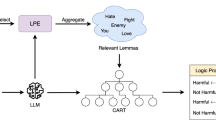Abstract
We do not know how humans reason, whether they reason using natural language (NL) or not and we are not interested in proving or disproving such a proposition. Nonetheless, it seems that a very expressive transparent medium humans communicate with, state their problems in and justify how they solve these problems is NL. Hence, we wished to use NL as a Knowledge Representation(KR) in NL knowledge-based (KB) sytems. However, NL is full of ambiguities. In addition, there are syntactic and semantic processing complexities associated with NL. Hence, we consider a quasi-NL KR with a tractable inference relation. We believe that such a representation bridges the gap between an expressive semantic representation (SR) sought by the Natural Language Processing (NLP) community and an efficient KR sought by the KR community. In addition to being a KR, we use the quasi-NL language as a SR for a subset of English that it defines. Also, it is capable of a general-purpose domain-independent inference component which is, according to semanticists, all what it takes to test a semantic theory in any NLP system. This paper gives only a flavour for this quasi-NL KR and its capabilities (for a detailed study see 14).
Knowledge Representation.
Preview
Unable to display preview. Download preview PDF.
Similar content being viewed by others
References
Cooper, R., Crouch, D., van Eijck, J., Fox, C., van Genabith, J., Jaspars, J., Kamp, H., Milward, D., Pinkal, M., Poesio, M., Pulman, S.: The Fracas Consortium, Deliverable D16. With additional contributions from Briscoe, T., Maier, H., Konrad, K. (1996)
Diller, A.: Z An Introduction to Formal Methods. Wing’s Library Problem. John Wiley and Sons Ltd., Chichester (1994)
Dowty, D.R., Wall, R.E., Peters, S.: Introduction to Montague Semantics. D. Reidel Publishing Co., Boston (1981)
Fyodorov, Y., Winter, Y., Francez, N.: A Natural Logic inference system. Inference in Computational Semantics (2000)
Hwang, C.H., Schubert, L.K.: Episodic Logic: A comprehensive, Natural Representation for Language Understanding. Minds and Machines 3(4), 381–419 (1993)
Iwanska, L.M.: Natural Language Processing and Knowledge Representation. In: Natural Language is a Powerful Knowledge Representation system, pp. 7–64. MIT press, Cambridge (2000)
Iwanska, L.M.: Natural Language Is A Representational Language. In: Knowledge Representation Systems based on Natural Language, pp. 44–70. AAAI Press, Menlo Park (1996)
McAllester, D., Givan, R.: Natural Language Syntax and First-Order Inference. Artificial Intelligence 56, 1–20 (1992)
McAllester, D., Givan, R., Shalaby, S.: Natural Language Based Inference Procedures Applied to Schuber‘s Steamroller. AAAI, Menlo Park (1991)
Schubert, L.K., Hwang, C.H.: Natural Language Processing and Knowledge Representation. In: Episodic Logic Meets Little Red Riding Hood-A comprehensive Natural Representation for Language Understanding, pp. 111–174. AAAI Press/MIT (2000)
Shapiro, S.C.: Natural Language Processing and Knowledge Representation. In: SNePs: A logicf or Natural Language Understanding and Commonsense Reasoning, pp. 175–196. AAAI Press/MIT (2000)
Stickel, M.E.: Schubert‘s Steamroller Problem: Formulations and Solutions. Journal of Automated Reasoning 2, 89–101 (1986)
Sukkarieh, J.Z.: Mind Your Language! Controlled Language for Inference Purposes. In: To appear in EAMT/CLAW 2003, Dublin, Ireland (2003)
Sukkarieh, J.Z.: Natural Language for Knowledge Representation. University of Cambridge (2001), http://www.clp.ox.ac.uk/people/staff/jana/jana.htm
Sukkarieh, J.Z.: Quasi-NL Knowledge Representation for Structurally-Based Inferences. In: Blackburn, P., Kolhase, M. (eds.) Proceedings of the Third International Workshop on Inference in Computational Semantics, Siena, Italy (2001)
Sukkarieh, J.Z., Pulman, S.G.: Computer Processable English and McLogic. In: Bunt, H., et al. (eds.) Proceedings of the Third International Workshop on Computational Semantics, Tilburg, The Netherlands (1999)
Author information
Authors and Affiliations
Editor information
Editors and Affiliations
Rights and permissions
Copyright information
© 2003 Springer-Verlag Berlin Heidelberg
About this paper
Cite this paper
Sukkarieh, J.Z. (2003). An Expressive Efficient Representation: Bridging a Gap between NLP and KR. In: Palade, V., Howlett, R.J., Jain, L. (eds) Knowledge-Based Intelligent Information and Engineering Systems. KES 2003. Lecture Notes in Computer Science(), vol 2773. Springer, Berlin, Heidelberg. https://doi.org/10.1007/978-3-540-45224-9_108
Download citation
DOI: https://doi.org/10.1007/978-3-540-45224-9_108
Publisher Name: Springer, Berlin, Heidelberg
Print ISBN: 978-3-540-40803-1
Online ISBN: 978-3-540-45224-9
eBook Packages: Springer Book Archive




